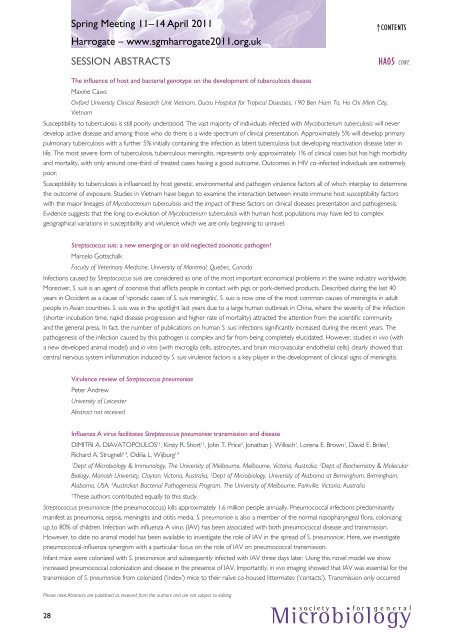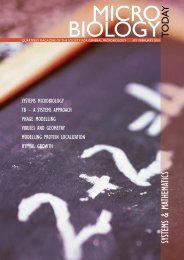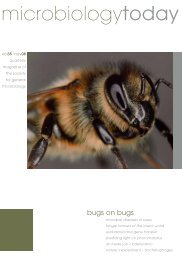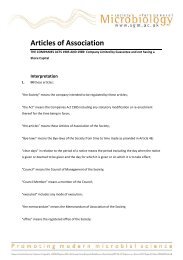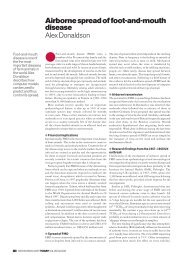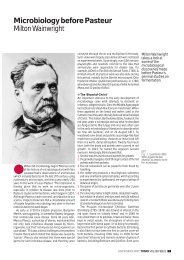Spring Conference 2011 - Society for General Microbiology
Spring Conference 2011 - Society for General Microbiology
Spring Conference 2011 - Society for General Microbiology
Create successful ePaper yourself
Turn your PDF publications into a flip-book with our unique Google optimized e-Paper software.
Please note: Abstracts are published as received from the authors and are not subject to editing.<br />
28<br />
<strong>Spring</strong> Meeting 11–14 April <strong>2011</strong><br />
Harrogate – www.sgmharrogate<strong>2011</strong>.org.uk<br />
SESSION AbSTrACTS<br />
↑Contents<br />
HA05 Cont.<br />
The influence of host and bacterial genotype on the development of tuberculosis disease<br />
Maxine Caws<br />
Ox<strong>for</strong>d University Clinical Research Unit Vietnam, Oucru Hospital <strong>for</strong> Tropical Diseases, 190 Ben Ham To, Ho Chi Minh City,<br />
Vietnam<br />
Susceptibility to tuberculosis is still poorly understood. The vast majority of individuals infected with Mycobacterium tuberculosis will never<br />
develop active disease and among those who do there is a wide spectrum of clinical presentation. Approximately 5% will develop primary<br />
pulmonary tuberculosis with a further 5% initially containing the infection as latent tuberculosis but developing reactivation disease later in<br />
life. The most severe <strong>for</strong>m of tuberculosis, tuberculous meningitis, represents only approximately 1% of clinical cases but has high morbidity<br />
and mortality, with only around one-third of treated cases having a good outcome. Outcomes in HiV co-infected individuals are extremely<br />
poor.<br />
Susceptibility to tuberculosis is influenced by host genetic, environmental and pathogen virulence factors all of which interplay to determine<br />
the outcome of exposure. Studies in Vietnam have begun to examine the interaction between innate immune host susceptibility factors<br />
with the major lineages of Mycobacterium tuberculosis and the impact of these factors on clinical diseases presentation and pathogenesis.<br />
Evidence suggests that the long co-evolution of Mycobacterium tuberculosis with human host populations may have led to complex<br />
geographical variations in susceptibility and virulence which we are only beginning to unravel.<br />
Streptococcus suis: a new emerging or an old neglected zoonotic pathogen?<br />
Marcelo Gottschalk<br />
Faculty of Veterinary Medicine, University of Montreal, Quebec, Canada<br />
infections caused by Streptococcus suis are considered as one of the most important economical problems in the swine industry worldwide.<br />
Moreover, S. suis is an agent of zoonosis that afflicts people in contact with pigs or pork-derived products. Described during the last 40<br />
years in Occident as a cause of ‘sporadic cases of S. suis meningitis’, S. suis is now one of the most common causes of meningitis in adult<br />
people in Asian countries. S. suis was in the spotlight last years due to a large human outbreak in China, where the severity of the infection<br />
(shorter incubation time, rapid disease progression and higher rate of mortality) attracted the attention from the scientific community<br />
and the general press. in fact, the number of publications on human S. suis infections significantly increased during the recent years. The<br />
pathogenesis of the infection caused by this pathogen is complex and far from being completely elucidated. However, studies in vivo (with<br />
a new developed animal model) and in vitro (with microglia cells, astrocytes, and brain microvascular endothelial cells) clearly showed that<br />
central nervous system inflammation induced by S. suis virulence factors is a key player in the development of clinical signs of meningitis.<br />
Virulence review of Streptococcus pneumoniae<br />
Peter Andrew<br />
University of Leicester<br />
Abstract not received<br />
Influenza A virus facilitates Streptococcus pneumoniae transmission and disease<br />
DiMiTri A. DiAVATOPOulOS 1† , Kirsty r. Short 1† , John T. Price 2 , Jonathan J. Wilksch 1 , lorena E. Brown 1 , David E. Briles 3 ,<br />
richard A. Strugnell 1,4 , Odilia l. Wijburg 1,4<br />
1 Dept of <strong>Microbiology</strong> & Immunology, The University of Melbourne, Melbourne, Victoria, Australia; 2 Dept of Biochemistry & Molecular<br />
Biology, Monash University, Clayton, Victoria, Australia; 3 Dept of <strong>Microbiology</strong>, University of Alabama at Birmingham, Birmingham,<br />
Alabama, USA; 4 Australian Bacterial Pathogenesis Program, The University of Melbourne, Parkville, Victoria, Australia<br />
† These authors contributed equally to this study.<br />
Streptococcus pneumoniae (the pneumococcus) kills approximately 1.6 million people annually. Pneumococcal infections predominantly<br />
manifest as pneumonia, sepsis, meningitis and otitis media. S. pneumoniae is also a member of the normal nasopharyngeal flora, colonizing<br />
up to 80% of children. infection with influenza A virus (iAV) has been associated with both pneumococcal disease and transmission.<br />
However, to date no animal model has been available to investigate the role of iAV in the spread of S. pneumoniae. Here, we investigate<br />
pneumococcal-influenza synergism with a particular focus on the role of iAV on pneumococcal transmission.<br />
infant mice were colonized with S. pneumoniae and subsequently infected with iAV three days later. using this novel model we show<br />
increased pneumococcal colonization and disease in the presence of iAV. importantly, in vivo imaging showed that iAV was essential <strong>for</strong> the<br />
transmission of S. pneumoniae from colonized (‘index’) mice to their naïve co-housed littermates (‘contacts’). Transmission only occurred<br />
s o c i e t y f o r g e n e r a l<br />
<strong>Microbiology</strong>


